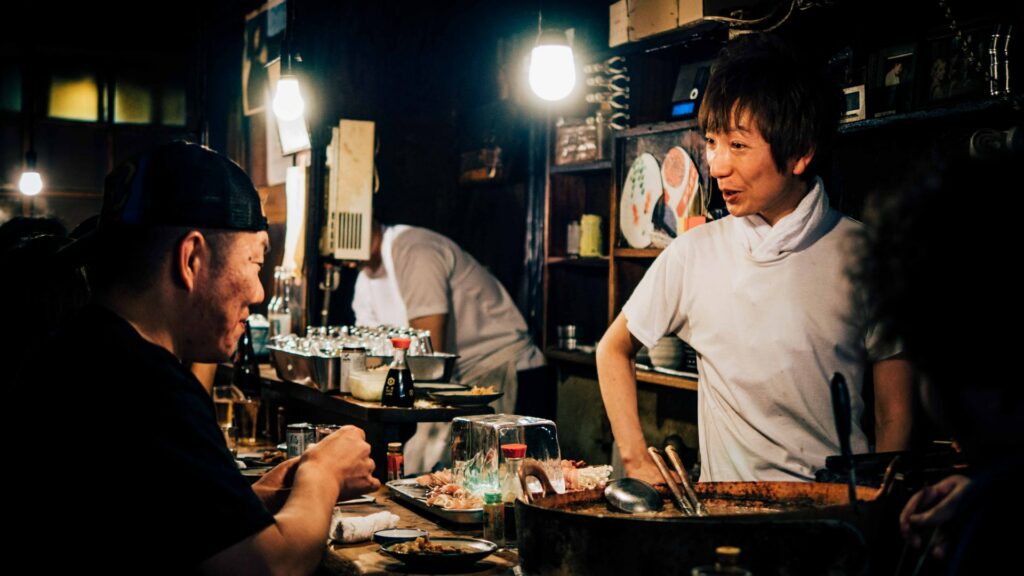Kansai dialect guide
With a total of 47 prefectures spanning the Japanese archipelago, there’s bound to be dialects that are unique to different regions in Japan. The most famous one of them all is no doubt the Kansai dialect (関西弁; kansai ben), which is spoken by locals residing in Osaka, Kyoto, Nara, Hyogo, Shiga, and Wakayama.
While the Kansai dialect generally follows the grammar of standard Japanese (標準語; hyoujun go), there are some quirks and word variations that may sound completely alien to those unacquainted with the local tongue. Scroll down to dive deep into the world of Kansai dialect.
For more language guides, check out:
- Anime speech habits to avoid IRL
- Tips to speak Japanese naturally
- Unique Japanese words that can’t be translated
Grammar
1. Negative verb conjugation
 Image credit: Lan Pham
Image credit: Lan Pham
One of the first grammar rules you’ll pick up in Japanese is conjugating verbs to form negatives with “ない” (nai). The Kansai dialect follows the same rule as the standard form, except instead of nai, “へん” (hen) is used. Rather than “食べない” (tabenai; I don’t eat), it’s “食べへん” (tabehen).
Note that for irregular verbs such as “する” (suru) and “来る” (kuru), the conjugated verbs are lengthened with one mora to “せぇへん” (seehen) and “こぅへん” (kouhen) respectively.
2. Copula だ becomes や
 Image credit: Adli Wahid
Image credit: Adli Wahid
You already know “です” (desu) and its less formal cousin, “だ” (da). Now, say hello to “や” (ya). One of the most obvious changes when it comes to Kansai dialect is the use of the copula “ya”. Take any sentence, replace the “da” in it with “ya”, and you’ll end up with Kansai dialect.
For instance, “言ったはずだろう” (itta hazu darou; I’m sure I told you) becomes “言ったはずやろ” (itta hazu yaro).
The same rules apply for plain past tense – “だった” (datta) to “やった” (yatta).
3. ん is often affixed to ending particles like ね or や
Another feature of the Kansai dialect that stands out is the use of “ねん” (nen), “やん” (yan), and even “やねん” (yanen). It’s not exactly translatable, but in a nutshell, you can remember them as counterparts to “なんだ” (nanda), “なのだ” (nanoda), and “なの” (nano) respectively.
Instead of saying “わたし病気なんだ・なの” (watashi byouki nanda/nano), the Kansai variation will be “うち病気やねん” (uchi byouki yanen).
4. よ is typically replaced with で or わ
 Image credit: Korie Cull
Image credit: Korie Cull
The emphasis marker “よ” (yo) is pretty commonplace in standard dialect, but “で” (de) and “わ” (wa) takes its place in the Kansai region.
Instead of “今日もう帰りますよ” (kyou mou kaeri masu yo), you’d hear “今日もう帰りますわ” (kyou mou kaeri masu wa). Another common pairing is “やで” (ya de), which translates to “だよ” (da yo).
These sentence-final particles may take non-native speakers some getting used to. This is specially so for wa, as it’s taught in standard Japanese that wa is associated with feminine speech. To differentiate them, look out for the intonation. Unlike the standard usage of wa, which has a rising intonation, the Kansai version has a sharp fall in pitch.
5. Dropping particles more frequently
 Image credit: Andrew Leu
Image credit: Andrew Leu
For Japanese language learners struggling with particles, the Kansai dialect will be heaven-sent as the colloquial regional dialect often omits particles, unless they are absolutely essential. This is especially so for the direct object marker “を” (wo), and quoting particles “って” (tte) and “と” (to).
For example, if one asks “中村さんという方は誰だと思う” (nakamura san toiu kata ha dare da to omou) in standard Japanese, the Kansai equivalent would be “中村さんいう方、誰や思う” (nakamura san iu kata, dare ya omou).
6. Accent and pitch patterns
 The Miya twins from Haikyuu!! speak the Kansai dialect.
The Miya twins from Haikyuu!! speak the Kansai dialect.
Image adapted from: Production I.G
Those with a trained ear will be able to identify the Kansai dialect immediately as their pitch pattern is a telltale sign that the speaker hails from western Japan. Generally speaking, the Kansai dialect has more pitch patterns and intonation variation than their Kanto counterpart, so the former is often described as more expressive and less monotonous.
7. Existence verb おる
 Image credit: Tayawee Supan
Image credit: Tayawee Supan
In standard Japanese, “いる” (iru) is used to refer to animate objects and “おる” (oru) is its humble language equivalent. In the Kansai dialect, however, “oru” is used extensively in place of “iru”. However, in some places such as Kyoto, the expression may come across as condescending, so it’s reserved for animals or someone with a lower status.
Common words and phrases
1. あかん (akan)
Before you acquaint yourself with grammar rules and inflection variations, you’d have to first understand the word “あかん” (akan). Synonymous with “だめ” (dame) or “よくない” (yokunai), akan means “no good”, and it’s an expression that’s frequently used in the Kansai area to describe anything from a negative situation to objects.
2. ええ (ee)
 Image credit: Daniel Hooper
Image credit: Daniel Hooper
Instead of “いい” (ii), “ええ” (ee) is used to mean “good” or as an agreeable reply. However, the word can only be used in plain form. For other forms such as the past tense, you have to abide by the rules of standard Japanese grammar. In other words, “よかった” (yokatta) is proper, but “えかった” (ekatta) is not.
3. まいど (maido)
 Image credit: Sunira Moses
Image credit: Sunira Moses
An abbreviation of “毎度お世話になっております” (maido osewa ni natte orimasu) or “毎度ありがとうございます” (maido arigatou gozaimasu), “まいど” (maido) is a greeting you’d hear when you step into a store. It’s synonymous with various meanings such as “welcome”, “thank you”, or just simply “hello”.
4. ほんま (honma)
The Kansai version of “本当に” (hontou ni), “ほんま” (honma) is another regional vernacular that means “real” or “true”. Just like the standard variation, “に” (ni) can be affixed to the end, turning it into an expression of surprise or shock when uttered with a rising intonation.
5. せや (seya)
 Image credit: Ice Tea
Image credit: Ice Tea
Another expression that’s frequently uttered by locals in the Kansai area is “せや” (seya). Translated as “そうだ” (souda; that’s right) in the standard form, “seya” is normally paired with “nen” (ねん) and used as an affirmative response.
6. ちゃう (chau)
 Image credit: Moujib Aghrout
Image credit: Moujib Aghrout
“ちゃう” (chau) simply means “違う” (chigau; to be different or wrong), although in some contexts, the Kansai dialect can replace “じゃない” (janai) in informal speech.
As it’s common to repeat the word twice for emphasis, the Kansai people have devised a tricky tongue twister which goes like this:
「あれ、チャウチャウちゃう?」(are, chau chau chau?)
「いや、チャウチャウちゃうんちゃう?」(iya, chau chau chau chau?)
The first line says, “Isn’t that a chow chow (dog breed)?” and the second one goes, “No, it’s not a chow chow, isn’t it?”
7. おおきに (ookini)

Image credit: Bruce Tang
“おおきに” (ookini) is the Kansai region’s way of saying “thank you” (arigatou; ありがとう), but its usage is more common in Kyoto, especially so in the kagai (花街, geisha and courtesan districts). It is an abbreviation for “おおきにありがとう” (ookini arigatou), which means “thank you very much”.
8. しょうもない (shoumonai)
Defined as “仕様もない” (shiyou mo nai) in standard Japanese, “しょうもない” (shoumonai) is used to describe something as being boring or pointless. In everyday conversation, the “い” (i) can be omitted and “しょうもなっ” (shoumona) is used instead.
9. はよ (hayo)
 Image credit: Gio Almonte
Image credit: Gio Almonte
“はよ” (hayo) stands for “早く” (hayaku), which means “to be quick” or “to hurry up”. Aside from its use in the Kansai region, the word can also be commonly heard in places such as Nagoya and Fukui.
10. なんでやねん (nande ya nen)
 Image adapted from: Yoshimoto Hall Official Channel
Image adapted from: Yoshimoto Hall Official Channel
Perhaps one of the hallmarks of manzai, a form of stand-up comedy that’s traditionally performed by a duo in Japan, “なんでやねん” (nande ya nen) is a phrase that’s often heard in comedy routines.
Roughly translated as “what are you going on about” or “there’s no way that’s true, isn’t it”, “nande ya nen” is uttered as a retort when the tsukkomi (straight man) reprimands the boke (fool). In real life, its usage is less harsh and it’s typically a response to light-hearted banter.
11. アホ (aho)
“アホ” (aho) basically means “バカ” (baka), which is “fool” or “idiot”. Though their definition is the same, each word is culture-specific and cannot be used interchangeably.
In the Kansai region, “aho” is used in a jovial manner, often in a joking tone, but it’s said that the word will come across as an insult to people from the Kantō area. Likewise, “baka” has a much more negative connotation in Kansai, while the reverse is true in Kantō.
12. なんぼ (nanbo)
 Image credit: Redd
Image credit: Redd
“なんぼ” (nanbo) refers to “いくら” (ikura) in standard Japanese, which means “how much”. It can refer to the price or quantity of something.
13. 炊いたん (taitan)

Image credit: Nestle Japan
The root word of “炊いたん” (taitan) is “炊く” (taku), which means “to cook”. This is usually used to refer to cooking rice. However, in the Kansai region, the definition of the word becomes closer to “煮る” (niru), which is “to boil or simmer”.
Hence, “炊いたん” (taitan) is Kansai’s equivalent of “煮物” (nimono), a kind of dish where a medley of root vegetables are simmered in a mix of dashi-based broth and soy sauce.
A basic guide to the Kansai dialect
With a bunch of new words and grammar at your disposal, you’d be able to easily discern the differences between Kansai dialect and standard Japanese. Delving into the world of regional dialects is a fun yet unconventional way to level up your language skills, so go forth and master a bunch of ways to say “thank you” in Japanese!
For more articles about the Japanese language, check out:
- Japanese internet slangs to master
- Loanwords that have completely different meanings in Japanese
- Basic Japanese phrases to know
- Commonly used phrases in convenience stores
- Basic slang to know
Cover image adapted from: Production I.G
